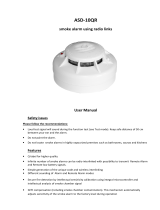SATEL ASD-250 5
2. Turn the cover counter-clockwise (Fig. 7) and remove it (Fig. 8).
3. If the detector is to work as a stand-alone device, remove the jumper (Fig. 2) and skip the
steps 5-9.
After the battery is installed, removing / placing the jumper will have no effect on the
detector operation.
4. Install the battery.
5. Add the detector to the wireless system (see the ABAX 2 / ABAX controller manual or the
INTEGRA 128-WRL control panel installer manual). The sticker with serial number which
shall be entered when registering the detector in the system can be found on the
electronics module.
In the INTEGRA / VERSA alarm system, the detector is identified as ASD-150.
Simultaneous operation of the detector by the ABAX 2 and ABAX controller /
INTEGRA 128-WRL alarm control panel is not possible.
6. Close the detector enclosure.
7. Put the detector at the place of its future installation.
8. Check the level of signal received from the detector by the ABAX 2 / ABAX controller or
the INTEGRA 128-WRL control panel. If the signal level is lower than 40%, select another
place for installation. Sometimes, it is sufficient to shift the device ten or twenty
centimeters to obtain a considerable improvement in the signal quality. You can also try to
turn the enclosure to check what effect the change of antenna position will have on the
signal strength.
The ARF-200 tester makes it possible to check the radio signal strength at the place of
future installation without having to put the detector there.
9. Remove the detector cover.
10. Use wall plugs (anchors) and screws to secure the enclosure base to the ceiling. The wall
plugs delivered with the device are intended for concrete, brick, etc. For other types of
surface (drywall, styrofoam), use the appropriately selected wall plugs.
11. Replace the detector cover and lock it with the screw.
12. Press the test / reset button (Fig. 1). Fire alarm should be triggered.
13. If in the premises where the detector is installed, any work is being carried out that may
lead to soiling of the optical chamber, put a plastic dust cover on the detector and leave it
there until the work is finished.
5. Maintenance
The detector should be subjected to regular checks for correct functioning. The periodic
checks should be carried out at least every 6 months. To check whether the detector is
operating properly, press the test / reset button (Fig. 1). This should trigger a fire alarm.
6. Cleaning the optical chamber
It is recommended that you have the optical chamber cleaned at least once a year. Cleaning
the chamber is necessary when the LED indicates fouling of the chamber (operation within
the ABAX 2 / ABAX system – 2 short flashes during periodical communication with controller
/ control panel; stand-alone mode – 2 short flashes every 30 seconds).
1. Start the service mode in the control panel (if the controller is connected to a SATEL
alarm control panel).













